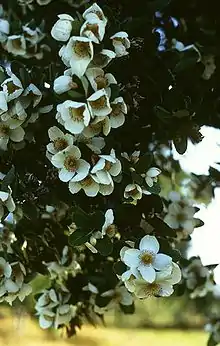Eucryphia cordifolia
Eucryphia cordifolia, the ulmo, is a species of tree in the family Cunoniaceae. It is found in Chile and Argentina. It is threatened by logging and habitat loss. The natural habitat is along the Andes Range from 38 to 43°S, and up to 700 meters (2300 ft) above sea level. It is a very elegant tree with a thick trunk and wide crown and can become over 12 m (40 ft) high.[2] It blooms in February and March, depending on latitude and altitude. The fruit is a capsule about 1.5 cm (0.6 in) length.
| Eucryphia cordifolia | |
|---|---|
 | |
| Scientific classification | |
| Kingdom: | Plantae |
| Clade: | Tracheophytes |
| Clade: | Angiosperms |
| Clade: | Eudicots |
| Clade: | Rosids |
| Order: | Oxalidales |
| Family: | Cunoniaceae |
| Genus: | Eucryphia |
| Species: | E. cordifolia |
| Binomial name | |
| Eucryphia cordifolia | |
| Synonyms[1] | |
| |
Cultivation and uses
Its flowers contain a highly appreciated aromatic nectar, harvested by introduced European bees and commercialized as "ulmo honey" (miel de Ulmo). The wood is light brown to brown, heavy, moderately firm, rather hard and quite resistant to decay. It is used locally for construction and very extensively as firewood.
It also grows well in Scotland and has been planted in the North Pacific Coast of the United States.
Chemical composition
Eucryphin, a chromone rhamnoside, can be isolated from the bark of E. cordifolia.[3]
References
- The Plant List: A Working List of All Plant Species, retrieved 21 August 2016
- Encyclopædia Britannica. Eucryphia cordifolia
- Eucryphin, a new chromone rhamnoside from the bark of Eucryphia cordifolia. R. Tschesche, S. Delhvi, S. Sepulveda and E. Breitmaier, Phytochemistry, Volume 18, Issue 5, 1979, pages 867-869, doi:10.1016/0031-9422(79)80032-1
- González, M. 1998. Eucryphia cordifolia. 2006 IUCN Red List of Threatened Species. Downloaded on 21 August 2007.
- "Eucryphia cordifolia". Enciclopedia de la Flora Chilena. Retrieved 27 June 2009.
- "Pictures and description of Eucryphia cordifolia". PlantenTuin Esveld. Retrieved 27 June 2009.
- "Eucryphia cordifolia in Washington Park Arboretum" (PDF). Washington Park Arboretum. Archived from the original (PDF) on 24 March 2009. Retrieved 27 June 2009.
- "Eucryphia cordifolia makes gaseous biodiesel!". Autobloggreen. Retrieved 27 June 2009.
External links
| Wikimedia Commons has media related to Eucryphia cordifolia. |

